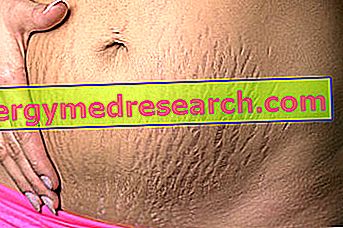Generality
Lumbosciatica, or lumbar radiculopathy, is a condition that causes pain in the lower back (lumbar area) and along one of the two lower limbs, including the foot.

This explains why the pain that characterizes lumbosciatalgia has the aforementioned location and irradiation.
An accurate diagnosis of lumbosciatalgia always starts from the physical examination and from the anamnesis.
Treatment depends on the severity of the symptoms and the triggering causes.
What is lumbosciatalgia?
Lumbosciatalgia, or lumbar radiculopathy, is a medical condition which, due to compression or irritation of the sciatic nerve, causes pain in the lower back (lumbar area), in one of the two buttocks and along one of the two lower limbs.
Lumbosciatica is also known as sciatica or lumbar sciatica .
For sciatica or sciatica, doctors mean a painful sensation that radiates along the entire sciatic nerve, from its roots to its extremity.
BRIEF ANATOMICAL RECALL OF THE SCIATIC NERVE
The sciatic nerve, or ischial nerve, is the largest and longest nerve in the human body.
It starts in the lower part of the back and runs through the lower limb, ending at the level of the foot.
Belonging to the category of mixed nerves, it is a derivation of the last two lumbar spinal nerves (L4 and L5) and of the first three sacral nerves (S1, S2 and S3): these nerve structures unite to form the sciatic nerve approximately at the level of the piriformis and gluteal muscles .
From the piriformis muscle and the gluteus, the ischial nerve descends along the posterior part of the thigh and, after passing the knee, branches off into various branches.
The branches of the sciatic nerve are distributed between the back of the leg, the front of the leg, the back of the foot and the sole of the foot.

MEANING OF THE WORD LOMBOSCIATALGIA
The word lombosciatalgia refers to all the main features of the condition to which it refers.
In fact, "- algia " in medicine means "pain"; "- sciat -" refers to the involvement of the sciatic nerve; finally, " loin -" refers to the involvement of the lumbar area of the back.
Causes
Lumbosciatica appears following a compression or irritation of the lumbar and / or sacral spinal nerves constituting the sciatic nerve.
The causes of compression / irritation of the sciatic nerve include:
- Spinal disc herniation . Responsible for a good 15% of sciatica cases, it is the main cause.
- The degenerative discopathy of the low back area
- Spinal stenosis of the lumbar-sacral tract
- Spondylolisthesis
- Piriformis syndrome . Doctors identify with this terminology the condition that the piriformis muscle compresses / irritates the sciatic nerve tract passing nearby.
In general, the piriformis muscle causes the compression / irritation of the sciatic nerve after having suffered a trauma or a contracture.
- Spinal tumors . In these circumstances, the compression / irritation of the sciatic nerve is the result of the mass effect of the tumor: by enlarging itself, the neoplasm pushes on the roots of the spinal nerves alternating their function or normal anatomy.
RISK FACTORS AND EPIDEMIOLOGY
According to experts, the risk factors of sciatica are:
- Advanced age . The aging of the human body involves a change in the shape of the spine. In some situations, this change is so profound that the spine could develop a herniated disc.
- Obesity . An excessive body weight can represent an excessive stress for the vertebral column, which can change the own anatomy and that of the connected spinal nerves.
- Work activities during which it is common to lift weights or twist your back . The researchers noted that those who do this type of work are particularly prone to sciatica, especially lumbosciatalgia.
However, it should be pointed out that, for the time being, no scientific evidence has shown the existence of a consequential link between the aforementioned work activities and the appearance of low back pain.
- A sedentary lifestyle . Statistical studies of incidence have shown that those who lead a sedentary lifestyle tend to develop lumbosciatalgia more frequently than those who lead an active life.
- Diabetes . This metabolic disease can have various complications, including the so-called diabetic neuropathy. Diabetic neuropathy is a form of peripheral neuropathy, in which deterioration of peripheral nerves takes place (NB: the sciatic nerve is a peripheral nerve).
To learn more about "diabetes complications", readers can click here.
- Arthritis .
- Pathologies of the spine .
- Trauma to the buttocks or thighs .
Symptoms and Complications
Present since the beginning of the condition, the pain that characterizes lumbosciatalgia can have noticeably different connotations, depending on the causes triggering the compression / irritation of the sciatic nerve.
Some sufferers feel a burning pain; others a sharp and penetrating pain; others still a mild pain that in certain circumstances produces shocks similar to electroshock.
In many patients, the pain sensation tends to worsen after exertion, coughing, sneezing or long periods of time spent sitting.
In general, lumbosciatica is unilateral . This means that the pain affects only one side of the body (eg right lumbar area, right gluteus and right lower limb).
In a generic case of lumbosciatalgia, the pain along the anatomical area covered by the sciatic nerve starts from the lumbar area of the back (root of the sciatic nerve) and can radiate along the whole lower limb, up to the foot.
OTHER SYMPTOMS
In addition to pain, lumbosciatica can cause, on the affected body side, a strange sensation of tingling, numbness (such as an alteration of sensitivity) and muscle weakness .
It is quite uncommon that the aforementioned pain and symptoms (when present) all localize at the same point: in fact, patients usually feel pain in one place, tingling in another, muscle weakness in another, etc.
WHEN TO REFER TO THE DOCTOR?
Lumbosciatica deserves the doctor's attention when:
- Symptoms tend to get worse instead of improving.
- The patient felt a sudden worsening of the symptoms, with a sharpening of the back pain, of the formicular and / or of the sense of muscular weakness.
- The patient developed the symptoms after a violent impact, for example after a car accident.
- The patient has little control of intestinal functions and bladder functions.
COMPLICATIONS
Lumbosciatica can cause complications if at its origin there is a serious alteration / lesion of the sciatic nerve.
In such circumstances, complications may consist of:
- Inability to walk
- Total loss of sensitivity in the affected leg
- Severe weakness in the leg involved
- Loss of control of intestinal and / or bladder functions
Diagnosis
The starting points for correctly diagnosing lumbosciatalgia are always the objective examination and the examination of the patient's clinical history (ie the anamnesis ). From both of these analyzes, doctors can draw various useful information, in some cases even sufficient for a definitive diagnosis.
The use of diagnostic instrumental procedures occurs only in the presence of severe pain or when the data collected during the physical examination and medical history suggest serious triggering conditions (severe disc herniation, spinal tumor, etc.).
INSTRUMENTAL EXAMINATIONS: WHAT ARE THEY?
The instrumental tests that help to diagnose the causes of a lumbosciatalgia are:
- X-rays to the spine
- Nuclear magnetic resonance (NMR) of the spine
- CT Scan (or Computerized Axial Tomography) of the spine
- Electromyography, for the evaluation of nerve impulses along the sciatic nerve
Treatment
If lumbosciatica is mild and at its origin there are no worrying causes, doctors find it unnecessary to resort to medicines or other types of treatment, since, in such circumstances, healing is very often spontaneous.
To justify the adoption of drugs, physiotherapy and / or surgical treatments is the possibility of a severe lumbosciatalgia, from the important triggering causes, or of a worsening of a condition of presumed lumbosciatalgia.
DRUGS
Among the possible drugs administered in the case of lumbosciatalgia, include:
- Anti- inflammatories of the NSAID type (Non-Steroidal Anti-Inflammatory Drugs), such as ibuprofen.
- Muscle relaxants, such as Muscoril.
- Tricyclic antidepressants or, alternatively, anticonvulsants . Usually indicated for other purposes (depression, epilepsy, respectively), these medicines have also been shown to be effective on pain from peripheral neuropathy (or neuropathic pain)
- Corticosteroids given intravenously. They are very powerful anti-inflammatories, which doctors prefer to use only in extreme cases, due to their serious side effects.
PHYSIOTHERAPY
The physiotherapy treatment for lumbosciatalgia consists of a rehabilitation program, which helps the patient to improve his posture, strengthen the back muscles and increase trunk flexibility.
SURGICAL INTERVENTION
Surgery is reserved for the most serious cases of low back pain and does not improve with the aforementioned treatments.
The surgical procedure is very delicate - this is why doctors only resort to it in the last resort - and consists in freeing the nerve from what causes it to be squeezed or irritated.
The causes that most frequently make surgery necessary are the spinal disc herniation and the changes in the lumbo-sacral tract of the spine.
TIPS AND HOUSEHOLD REMEDIES
Experts in the field of lumbosciatica recommend to observe a short period of rest from heavy or sporting activities, but not to exaggerate, because long-term physical inactivity often leads to a worsening of symptoms.
Furthermore, they consider it particularly useful:
- The application of cold packs, alternated with hot packs, at the level of the painful area (s).
- Daily muscle stretching, or so-called stretching . There are exercises for stretching the back, able to effectively alleviate the compression of the sciatic nerve.
Prognosis
Generally, the prognosis of lumbosciatica depends on the triggering factors.
If the causes are curable, lumbosciatica heals with good results and in a short time; vice versa, if the causes are difficult to treat, lumbosciatalgia can have very long healing times (we talk about several months).
Prevention
At the moment, there is no remedy that prevents lumbosciatalgia, with a probability close to or equal to 100%.
However, there are various precautionary measures that greatly reduce the risk:
- Use your body properly, while lifting weights, and avoid excessive back torsions. There are numerous online guides that teach how to lift a weight without burdening the spine.
- Maintain a correct posture, especially in a sitting position, so as not to alter the normal anatomy of the spine.
- Exercise regularly, because inactivity is a predisposing factor for low back pain.



